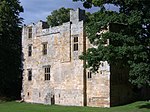Corbridge Bridge
Bridges in NorthumberlandCorbridgeCrossings of the River TyneGrade I listed bridgesGrade I listed buildings in Northumberland ... and 3 more
Northumberland building and structure stubsUnited Kingdom bridge (structure) stubsUse British English from December 2017

Corbridge Bridge is a 17th-century stone bridge across the River Tyne at Corbridge, Northumberland, England. The bridge used to carry the A68 road over the River Tyne, but since the opening of the Hexham bypass (A69) the A68 now crosses by the Styford Bridge, 3 miles (5 km) downstream of Corbridge. It is listed as a Grade I listed building by Historic England.
Excerpt from the Wikipedia article Corbridge Bridge (License: CC BY-SA 3.0, Authors, Images).Corbridge Bridge
B6321,
Geographical coordinates (GPS) Address External links Nearby Places Show on map
Geographical coordinates (GPS)
| Latitude | Longitude |
|---|---|
| N 54.9722 ° | E -2.0188 ° |
Address
Corbridge Bridge
B6321
NE45 5AU
England, United Kingdom
Open on Google Maps








